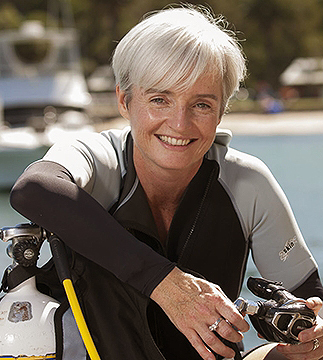
Marine ecologist Emma Johnston’s high-profile work in Sydney Harbour is changing the way young women view science, writes Deborah Smith.
Professor Emma Johnston still gets a buzz whenever she goes diving. “It’s spine-tingling to see this other world and to travel through it, interacting with so many different species,” she says. Sydney Harbour, with its seagrass meadows, kelp forests and more than 350 species of fish, is a perfect place to journey under water. “It’s one of the most biologically diverse harbours in the world,” says Johnston. “But it also has a legacy of toxic contamination, as well as ongoing threats.”
That makes it a prime spot for Johnston too. The UNSW marine biologist is recognised internationally for her innovative research on the impact of human activity on complex marine ecosystems – including the effects of pollution, dredging, habitat destruction and introduction of invasive species.
As director of the Sydney Harbour Research Program at the Sydney Institute of Marine Science, she heads a five-year project with a $10 million budget that will provide the information needed to sustainably manage the vast natural and economic resources of this jewel in the city’s crown.
Her multidisciplinary team of 35 scientists works with government and industry to better understand the threats to the harbour’s health. Major projects include a study of stormwater run-off in the upper catchment and a survey of all the human activity carried out on the harbour.
Johnston’s highly original research approach, which combines traditional ecology with ecotoxicology, has also taken her from the warm tropics to icy Antarctic waters, where she studies the threat from climate change to the unique organisms living on the polar sea floor.
An outstanding communicator of science, she co-stars on Coast Australia, a TV series that explores the country’s coastline.
She says that being a TV presenter has allowed her to swim for the first time with dugongs and whale sharks which was “a lot of fun”. But her main motivation is to reveal to the public the hidden underwater world she finds so fascinating.
“I think there is a lack of empathy for marine life, largely driven by people not being able to see it and bond with it. The more we show people how remarkable these ecosystems are, the more likely it is they will want to take better care of them,” she says.
For her “leadership and groundbreaking research”, Johnston was honoured as the inaugural recipient of the Australian Academy of Science’s Nancy Millis Medal for Women in Science – with the announcement made on International Women’s Day. Johnston, who has been involved in two gender equity programs at UNSW, hopes the new award will encourage more women into scientific research careers.
“I think it is incredibly important to have female role models and recognition of women’s achievements. Part of being able to become a successful scientist is to have the confidence to try,” she says. More flexibility in career structure, however, is also vital for women. Johnston was fortunate her career was kick-started by obtaining a continuing position at UNSW on completion of her PhD: “It meant I had time to build a lab and a research program and get established before I had children.”
An award-winning teacher, she now leads a team of 20 postgraduate and postdoctoral researchers. “One of the most important and fulfilling parts of my job is training the next generation of environmental scientists. And they inspire me with their energy and motivation,” she says.
Johnston won a Young Tall Poppy Award in 2007 and a NSW Science and Engineering Award for Excellence in Biological Sciences in 2012. She has been awarded more than $6.5 million in external research funding. She is regional editor of the international journal Conservation Biology and associate editor of Ecotoxicology, vice-president of Science and Technology Australia, and a member of the NSW government’s marine estate expert knowledge panel.
This story was originally written for and published on Uniken, UNSW Australia's flagship magazine
